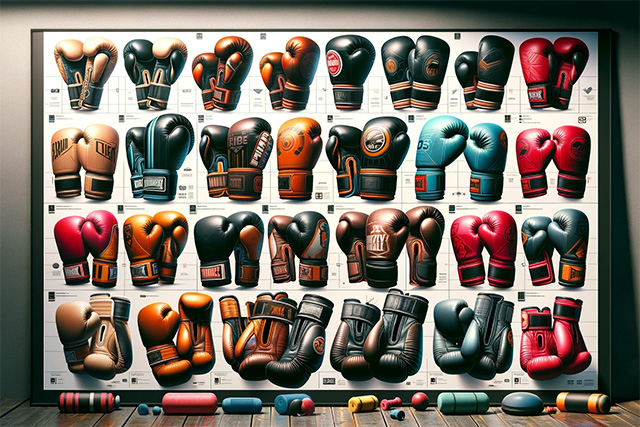
Choosing the Perfect Boxing Gloves
Boxing gloves are the fundamental tool that epitomizes the sport’s essence – the perfect blend of technique, precision, and resilience. In the unforgiving arena of the boxing ring, the right pair of gloves can make all the difference between victory and defeat. This exploration delves into the pivotal elements that define the perfect boxing gloves, equipping you with the knowledge to choose the ideal pair for your journey in the “Sweet Science.”
Types of Boxing Gloves:
When it comes to boxing gloves, it’s crucial to understand that not all gloves are created equal. There are different types of boxing gloves designed for specific purposes:
- Training Gloves: Training gloves are the workhorses of your boxing equipment. They are designed for daily workouts, bag work, and mitt training. These gloves are typically more durable and provide excellent hand protection during your training sessions.
- Competition Gloves: Competition gloves, on the other hand, are specialized gloves designed specifically for sanctioned boxing matches. They are usually lighter and offer less padding to ensure a fair fight. These gloves must meet strict regulations to ensure the safety of both fighters.
- Specialized Gloves: Specialized gloves cater to unique needs, such as sparring gloves, which are engineered to protect both you and your sparring partner during practice bouts. There are also bag gloves, which are lighter and ideal for heavy bag training.
Features and Attributes:
Now, let’s dive deeper into the features and attributes that distinguish one pair of boxing gloves from another:
- Size and Weight: The size and weight of your gloves are crucial considerations. Gloves range from 8 ounces to 20 ounces or more. Heavier gloves provide more hand protection, while lighter gloves are typically used for competitions.
- Materials: Boxing gloves are made from various materials, including genuine leather, synthetic leather, and vinyl. Genuine leather gloves tend to be more durable and comfortable but come at a higher price.
- Closure Systems: Gloves come with different closure systems, such as lace-up and Velcro straps. Lace-up gloves offer a secure fit but may require assistance to put on and take off. Velcro straps provide convenience and are easy to manage.
- Padding: The quality and thickness of padding greatly affect impact absorption. Quality gloves have multi-layer foam padding to protect your hands and reduce the risk of injury.
- Thumb Attachment: Gloves may have attached or separate thumbs. Attached thumbs offer better thumb protection, preventing accidental eye gouges during sparring.
- Ventilation: Proper ventilation is essential to keep your hands cool and comfortable during long training sessions. Look for gloves with breathable materials and perforations.
Choosing the Right Size and Weight:
Selecting the correct size and weight of boxing gloves depends on your specific needs and body size. Lighter gloves are suitable for speed and accuracy training, while heavier gloves offer better protection and conditioning. Be sure to try on gloves and consult with experts to find the perfect fit for your hands.
Brands and Manufacturers:
There are numerous reputable brands and manufacturers in the boxing glove industry. Some of the most renowned names include Everlast, Cleto Reyes, Venum, and Grant. Each brand has its unique qualities and reputation, so it’s essential to research and read detailed reviews and product comparisons before making a decision.
Boxing Glove Care and Maintenance:
To ensure the longevity and hygiene of your boxing gloves, proper care and maintenance are essential. Here are some tips:
- Cleaning and Sanitizing: Regularly clean the inside and outside of your gloves with a mild detergent and a damp cloth. Use disinfectant sprays or wipes to eliminate odor-causing bacteria.
- Storage: Store your gloves in a cool, dry place to prevent mold and odor. Avoid leaving them in direct sunlight or damp areas.
- Lining Replacement: Over time, the lining of your gloves may wear out. Know when it’s time to replace the lining or seek professional repair services.
Boxing Glove Accessories:
Enhance your boxing glove experience with the following accessories:
- Hand Wraps: Hand wraps provide additional wrist and hand support during training and sparring.
- Deodorizers: Specialized deodorizers help keep your gloves fresh and odor-free.
- Glove Dryers: Glove dryers help eliminate moisture and prevent mold growth.
- Inners: Inners are thin, moisture-wicking gloves that go inside your boxing gloves for added comfort and hygiene.
- Bags: Invest in a quality gym bag to keep your gloves and other gear organized.

Safety and Regulations:
Safety should always be a top priority in boxing. Different types of gloves must comply with safety standards and regulations. Padded gloves play a crucial role in preventing injuries and protecting both fighters in the ring. Ensure your gloves meet the required safety standards for your training and competitions.
Historical Evolution:
The history of boxing gloves is a fascinating journey that has seen significant milestones and innovations. From their humble origins as bare-knuckle protectors to the modern, technologically advanced gloves we have today, understanding the evolution of boxing gloves adds depth to your appreciation of the sport.
Comparative Analysis:
When choosing the perfect boxing gloves, conducting a comparative analysis can be immensely helpful. Consider factors like price, durability, comfort, and user reviews. Create a table or chart for easy comparison, allowing you to make an informed decision.
Customization Options:
For serious athletes and enthusiasts, many brands offer customization options for boxing gloves. You can select your preferred design, colors, and even personalize features. Custom gloves not only showcase your unique style but also provide a tailored fit for enhanced performance.
Boxing Glove Technology:
The world of boxing gloves is not immune to technological advancements. Recent innovations include impact-absorbing materials and smart glove technologies that track your performance and provide valuable data for improvement. Stay updated on these advancements to maximize your training benefits.
Conclusion:
In conclusion, choosing the perfect boxing gloves is a crucial decision for any boxer. The right gloves can enhance your performance, protect your hands, and ensure your safety in the ring. By considering factors such as type, size, materials, and brand reputation, you can make an informed choice that aligns with your boxing goals. Remember that proper care and maintenance are essential to prolong the lifespan of your gloves. Whether you’re a seasoned pro or just starting your boxing journey, investing in the right gloves is a step toward success in the world of boxing. Explore related articles and product reviews for more in-depth information, and step into the ring with confidence and style




